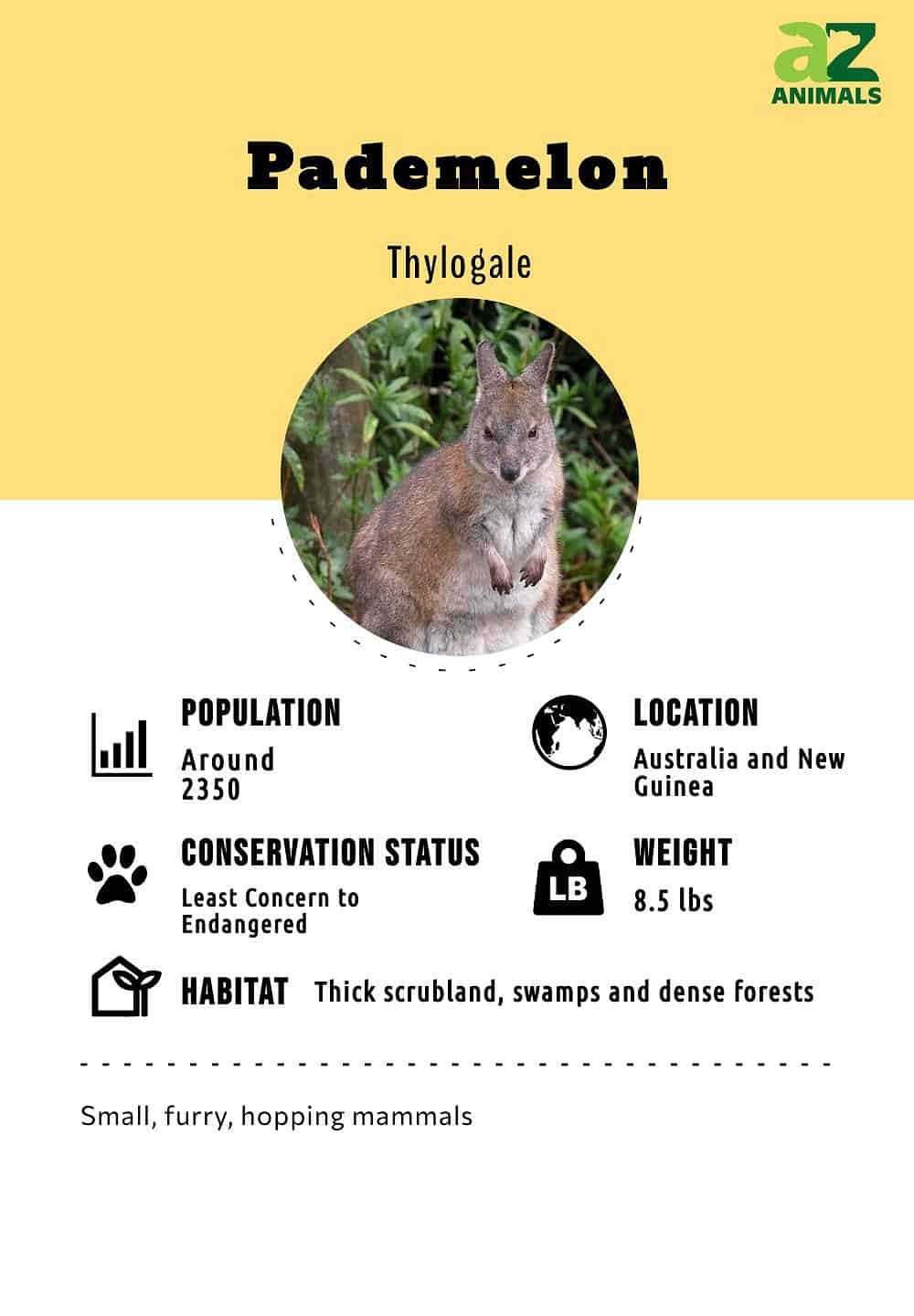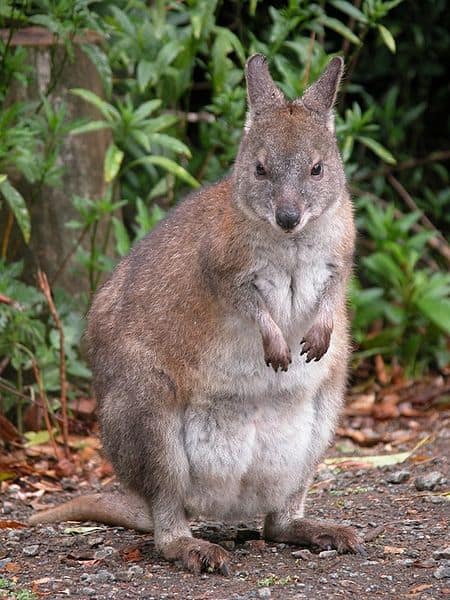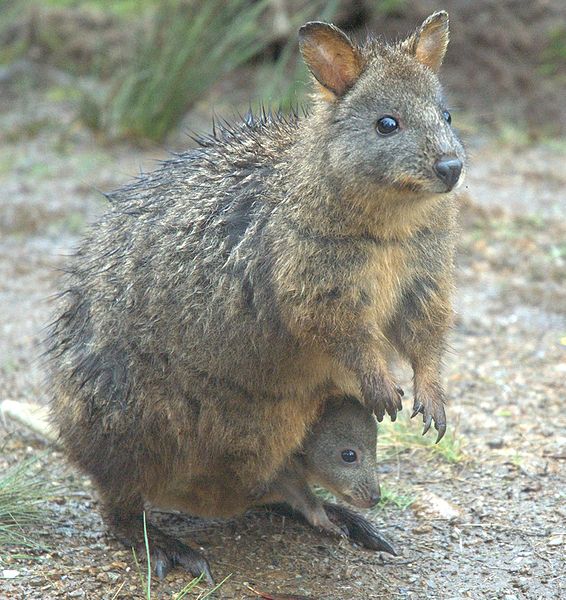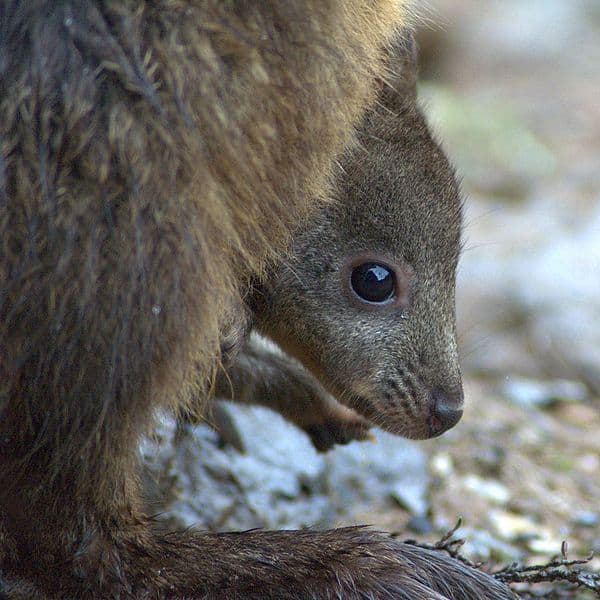Pademelon
Thylogale
Inhabits the jungles of the far east!
Advertisement
Pademelon Scientific Classification
- Kingdom
- Animalia
- Phylum
- Chordata
- Class
- Mammalia
- Order
- Diprotodontia
- Family
- Macropodidae
- Genus
- Thylogale
- Scientific Name
- Thylogale
Read our Complete Guide to Classification of Animals.
Pademelon Conservation Status
Pademelon Facts
- Main Prey
- Grasses, Herbs, Shoots
- Habitat
- Dense rainforest and shrubland
- Predators
- Foxes, Dogs, Dingos
- Diet
- Herbivore
- Average Litter Size
- 1
View all of the Pademelon images!
A cousin of the kangaroo and the wallaby
Found in Australia’s forest and island areas, the pademelon is a small to mid-size marsupial. It is a solitary animal and a nocturnal one. There are seven pademelon species, but the animal population numbers are suffering because many of them are losing their habitats and being hunted. When awake, these marsupials forage for berries, herbs, grass, and leaves. If the animal detects a predator, it uses its hind legs to thump the ground, alerting other nearby forest animals of the danger.
Top Facts
• Pademelons live in diverse environments including thick bush, forests, and swampy areas
• The animals are usually a blend of black, brown, gray, and red
• Male pademelons are typically about twice as large as females
• The species forms tunnels in the bushes and grasses of its habitats to reach food and escape predators

Scientific Name

The pademelon, like all marsupials, has a common trait of big feet, or a macropod.
©PanBK / Creative Commons – Original
The pademelon’s scientific name is Thylogale, and the animals are a part of the Macropodidae family. They are of the Mammalia class and are included in the Macropodidae subfamily. The definition of “macropod” is big foot. This is a trait that’s common in marsupials like the pademelon. Often, macropods feature back legs that are much bigger than their front legs. Members of this family also often have large back feet and powerful tails that help them balance.
The name pademelon comes from the Dharuk Aboriginal word “badimaliyan.” The seven different types of pademelons are Tasmanian, Brown’s, Dusky, Calaby’s, mountain, red-legged and red-necked. The dusky pademelon has had many names. In the past, locals called it the Aru Islands wallaby. Before that, it was known as the philander, which means friend of man. In the second series of the book “Travels” by Cornelis de Bruijin, the characters called this mammal the philander.
Evolution And History
The pademelon belongs to a larger genus of Macropodidae, a marsupial family that is thought to have evolved from mammals of the Therian class. It is believed that marsupials began to deviate from the therian class of mammals around 90 million years ago. These marsupials most likely came from North America and eventually expanded into South American and Asia. During the migration process, as land masses began to break off and form what became Australia, they became isolated to evolve into the marsupial of today.
The fossil evidence of a Tasmanian pademelon was found in Australia, dating back to the early Pliocene era, which gives evidence that this species may have crossed from the island of Tasmania onto the mainland during times of low sea levels.
Appearance And Behavior

Pademelons are similar in shape to kangaroos and wallabys, but much smaller.
©Gaz / Creative Commons – Original
Small and similar in body shape to their kangaroo and wallaby cousins, you can tell that you’ve come across a pademelon from its shorter height and thicker body. Pademelons get around by hopping on their hind legs. They carry their front legs high into their bodies in front of them, and they have small paws and sharp claws.
Pademelons have soft fur, and they generally feature a dark stripe along the cheek that extends from the side of their mouth to just behind the eye. Over the dark stripe is a section of white fur. The animal has a lighter color fur on its belly than it does on its back and legs. Pademelons have a noticeable stripe along the hip too. The animal has a short, stubby tail that’s covered with a small amount of sparse fur. Their feet are soft and coated with dark brown fur. The animal species have round ears that give it Giving it a mouse-like appearance. Female pademelons have a belly skin fold that covers a furry pouch.
When it comes to behavior, pademelons prefer to be on their own. The only time that they meet up is to mate and sporadically graze together in grassy clearings. The animal species travel long distances looking for food. They make their way through the forest from early in the morning until evening. To keep up their energy, the animals rest several times a day. As pademelons travel to and from their grazing areas, they form tunnels and trails through the foliage.
Pademelons are harmless, curious animals that often permit people to walk up to them for a photo opportunity before hopping slowly away. A fully mature male pademelon can grow to weigh as much as 15 pounds. Female pademelons usually weigh about 8 pounds. An adult animal’s length is from around 3.3 feet to almost 5 feet. You can recognize a male pademelon by its larger body size, defined muscles, and broad forearms and chest.
Habitat

This small marsupial resides in the thick forests of eucalyptus.
©PanBK at the English language Wikipedia / Creative Commons – Original
Pademelons make their homes in rainforest areas, particularly in thick eucalypt forests. The animals prefer to live near the forest’s edge. They make their homes in coastal areas of Australia, Tasmania, and Papua New Guinea. You’ll find red-necked pademelons in the areas of New South Wales and Queensland. They also live in the south-central part of New Guinea. If you’re in Tasmania and come across a pademelon, it will likely be a red-bellied or Tasmanian one. Years ago, this type of pademelon also lived in the southeastern region of Australia’s mainland. New Guinea is home to the dusky pademelon. This part of the world features a humid subtropical climate, one with cool winter temps, warm summers, and plenty of rain year-round.
Diet
What do pademelons eat? Pademelons are herbivores, eating grass, leaves, herbs, berries, ferns, mosses, and shoots. The Tasmanian pademelon dines on nectar-bearing flowers when available, while the red-legged pademelon typically eats fallen leaves. This type of pademelon may also obtain sustenance from fruit like the Moreton Bay fig and the Burdekin plum. In some cases, the animals eat tree bark and young trees.
Predators And Threats
The pademelon’s main predators include dogs, foxes, wedge-tail eagles, quolls, Tasmanian devils, and feral cats. Humans are also a threat to the species due to clearing land to make way for homes, farmland, and other developments. This same trend has resulted in kangaroos and wallabies seeking new habitats in areas where pademelons generally live, which also decreases the food supply for all of the species. Another risk to pademelons is rabbits. While not a predator, rabbits are a competing species that consumes the same grasses as pademelons and can reduce the availability of a primary food source.
In the past, aborigines and the area’s settlers also valued pademelon meat. In Tasmania and the state’s outer islands, residents kill off pademelons to keep their numbers low. Residents also hunt them for their meat and fur. According to the IUCN red list pademelon range from least concern to endangered, based on the specific species.
Reproduction, Babies And Lifespan

Pademelons have babies that are called a joey and will live it their mother’s pouch until 6 months old.
©PanBK / Creative Commons – Original
Pademelons breed year-round, and they are polygynandrous, meaning they have multiple partners. While the animal species technically breed all year long, an estimated 70% of their births happen toward the start of the winter months. When a male selects a mate, he makes soft noises at her. The sound is similar to the one that a female makes when she is calling her baby to come to her. For the species, fertilization happens internally with the gestation period lasting for an estimated 30 days. Pademelons usually only have one baby, and when it is born, it is a small, blind, defenseless, furless embryo.
Like kangaroos, an embryo pademelon is called a joey. Right after the joey is born, the baby makes his or her way from the mother’s birth canal to her pouch. Once there, it attaches itself to one of her teats. Female pademelons have four teats. The joey will live and grow from this undeveloped state within its mother’s pouch until it reaches 6 months old. At this age, the joey will start to venture outside of the female pademelon’s pouch. Baby pademelons return to their mother’s pouch for food until the mom decides to wean him or her. Weaning usually happens between 8 months old and 12 months old.
Kangaroos experience birth the same way. When a baby kangaroo is born, it is usually about 2 centimeters long. Kangaroo babies typically weigh less than one gram. Just like pademelon joeys, kangaroo joeys make their way to their mother’s pouch and attach themselves to one of her teats. Kangaroo joeys stay in their mother’s pouch until they are 7 months to 10 months old.
Pademelon joeys have the birth advantage of being protected by their mothers until they are big and strong enough to take care of themselves. The animal species becomes sexually mature at 14 months to 15 months old.
Pademelons live for 4 years to 8 years when they are living in the wild. In captivity, they live for around 10 years. According to disease surveys, pademelons can suffer from toxoplasma. When the animals are kept as pets, they may contract roundworms along with selenium and vitamin E deficiencies. They can also get salmonellosis, which is a mouth disease. If you decide to keep one as a pet, be sure to take your animal friend to an exotic vet annually.
Population
The Department of Primary Industries, Parks, Water, and Environment is an organization that has been conducting yearly animal surveys in Tasmania for almost 45 years, and it counts the number of pademelons in the area. In 2018, the organization counted 134 pademelons in the Central region part of the state and 345 in Finders Island. The organization determined that there were 30 animals on King Island, 917 in North East Tasmania, and 582 in North West Tasmania. It also counted 398 pademelons in South East Tasmania and 32 in South West Tasmania.
Pademelon FAQs (Frequently Asked Questions)
What’s the Difference Between a Wallaby and a Pademelon?
There are several differences between pademelons and wallabies. Pademelons are smaller with stubby tails that are thicker than a wallaby’s tail with a slight amount of hair. Pademelons have smaller ears too. However, both species move from place to place by hopping.
Can You Eat Pademelon?
Locals ate pademelon meat in the past, and you may find it on the menu in some restaurants that sell game meat. According to statistics, an estimated 30,000 to 40,000 pademelons and Bennetts Wallabies are killed annually for the domestic meat market. They are used for pet food and sold to restaurants. Under Tasmania’s commercial and recreational licenses, there are no restrictions on the number of animals that hunters can kill.
Shooting pademelons has a negative effect on the animal’s population. Hunters aim for the larger animals, which impacts the pademelon population since the larger animals are usually males. As a result, the population experiences a gender balance issue that can cause long-term effects on the population’s diversity. Some hunters use dogs to scare the animals out of their habitats. Dogs cause the animals to experience stress, injuries and death.
What is a Small Wallaby Called?
Small kangaroos are typically referred to as wallabies. The term refers to a kangaroo that has hind feet that are less than 25 cm long. The tammar wallaby, which is from the southwestern part of Australia, and the parma wallaby, from New South Wales, are the smallest known wallabies in the world.
Are Pademelons Native to Tasmania?
Several types of pademelon species are native to Tasmania and Australia. These are the red-bellied pademelon and the thylogale billardierii. Both species are now only in Tasmania. In past years, red-bellied pademelons were found throughout Australia’s mainland, but they have been extinct from the area for more than 100 years.
Are Pademelons herbivores, carnivores, or omnivores?
Pademelons are Herbivores, meaning they eat plants.
What Kingdom do Pademelons belong to?
Pademelons belong to the Kingdom Animalia.
What phylum do Pademelons belong to?
Pademelons belong to the phylum Chordata.
What class do Pademelons belong to?
Pademelons belong to the class Mammalia.
What family do Pademelons belong to?
Pademelons belong to the family Macropodidae.
What order do Pademelons belong to?
Pademelons belong to the order Diprotodontia.
What genus do Pademelons belong to?
Pademelons belong to the genus Thylogale.
What type of covering do Pademelons have?
Pademelons are covered in Fur.
In what type of habitat do Pademelons live?
Pademelons live in dense rainforests and shrublands.
What do Pademelons eat?
Pademelons eat grasses, herbs, and shoots.
What are some predators of Pademelons?
Predators of Pademelons include foxes, dogs, and dingos.
What is the average litter size for a Pademelon?
The average litter size for a Pademelon is 1.
What is an interesting fact about Pademelons?
Pademelons inhabit the jungles of the far east!
What is the scientific name for the Pademelon?
The scientific name for the Pademelon is Thylogale.
What is the lifespan of a Pademelon?
Pademelons can live for 4 to 8 years.
How fast is a Pademelon?
A Pademelon can travel at speeds of up to 34 miles per hour.
Thank you for reading! Have some feedback for us? Contact the AZ Animals editorial team.
Sources
- David Burnie, Dorling Kindersley (2011) Animal, The Definitive Visual Guide To The World's Wildlife / Accessed December 21, 2009
- Tom Jackson, Lorenz Books (2007) The World Encyclopedia Of Animals / Accessed December 21, 2009
- David Burnie, Kingfisher (2011) The Kingfisher Animal Encyclopedia / Accessed December 21, 2009
- Richard Mackay, University of California Press (2009) The Atlas Of Endangered Species / Accessed December 21, 2009
- David Burnie, Dorling Kindersley (2008) Illustrated Encyclopedia Of Animals / Accessed December 21, 2009
- Dorling Kindersley (2006) Dorling Kindersley Encyclopedia Of Animals / Accessed December 21, 2009
- David W. Macdonald, Oxford University Press (2010) The Encyclopedia Of Mammals / Accessed December 21, 2009


















